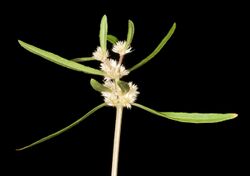Biology:Alternanthera denticulata
| Alternanthera denticulata | |
|---|---|

| |
| Scientific classification | |
| Kingdom: | Plantae |
| Clade: | Tracheophytes |
| Clade: | Angiosperms |
| Clade: | Eudicots |
| Order: | Caryophyllales |
| Family: | Amaranthaceae |
| Genus: | Alternanthera |
| Species: | A. denticulata
|
| Binomial name | |
| Alternanthera denticulata | |
| Synonyms[3] | |
|
Alternanthera denticulata var. micrantha Benth. | |
Alternanthera denticulata (common name lesser joyweed) is a small prostrate white-flowering herb in the Amaranthaceae family.[4] It is native to all states and territories of Australia ,[5] New Guinea, and the North Island of New Zealand.[3] It is also one of the food plants of the varied eggfly, Hypolimnas bolina nerina.[6]
The species was first described in 1810 by Robert Brown.[1][2]
Description
Alternanthera denticulata is a prostrate to erect perennial herb, whose stems root at the nodes. The stems are green flushed pink, and sparsely hairy to being without a covering. The nodes are tomentose (that is, covered with dense intertwined hairs). The leaves are (20-)30-80 by 6–12 mm, and a light green, yellow green or flushed pink, with both the midrib and lateral veins being pink. The leaf margins are finely toothed,[7] or entire.[5]
Habitat and flowering
In Western Australia, it grows on both sand and clay soils, on the banks of creeks, rivers and swamps, flowering from April to August.[4] On the North Island of New Zealand, it is found on coastal and lowland wetlands, lake margins and other damp ground, flowering from January to December.[7]
Conservation status
In New Zealand, it has been assessed by the Department of Conservation as "Data Poor" but "Secure Overseas".[8]
References
- ↑ 1.0 1.1 "Alternanthera denticulata R.Br.". Australian Plant Name Index (APNI), IBIS database. Centre for Plant Biodiversity Research, Australian Government. https://biodiversity.org.au/nsl/services/rest/name/apni/84154.
- ↑ 2.0 2.1 , pp. 417, https://www.biodiversitylibrary.org/page/2954573, Wikidata Q7247677
- ↑ 3.0 3.1 "Alternanthera denticulata R.Br. | Plants of the World Online | Kew Science" (in en). http://powo.science.kew.org/taxon/urn:lsid:ipni.org:names:59157-1.
- ↑ 4.0 4.1 "Alternanthera denticulata R.Br.". FloraBase. Western Australian Government Department of Parks and Wildlife. https://florabase.dpaw.wa.gov.au/browse/profile/2648.
- ↑ 5.0 5.1 S.W.L. Jacobs & L.Lapinpuro (1990). "PlantNET - FloraOnline: Alternanthera denticulata". https://plantnet.rbgsyd.nsw.gov.au/cgi-bin/NSWfl.pl?page=nswfl&lvl=sp&name=Alternanthera~denticulata.
- ↑ "Varied Eggfly". http://www.butterflyencounters.com.au/Varied_Eggfly.html.
- ↑ 7.0 7.1 "Alternanthera denticulata" (in en). https://www.nzpcn.org.nz/flora/species/alternanthera-denticulata/.
- ↑ , pp. 54, Wikidata Q76346849
Wikidata ☰ Q21239037 entry
 |

